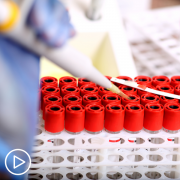Which Myeloma Treatment Is Right for You? What You Need to Know from Patient Empowerment Network on Vimeo.
What should you know before deciding which treatment is best for YOUR myeloma? Myeloma expert Dr. Saad Usmani reviews essential testing that may help guide treatment decisions, and discusses the impact of risk stratification on myeloma care. Dr. Usmani also provides an overview of treatments in development, the importance of clinical trials, and shares why he’s hopeful about the future of myeloma research.
Dr. Saad Usmani is the Chief of Myeloma Service at Memorial Sloan Kettering Cancer Center in New York City. Learn more about Dr. Usmani, here.
Download Guide
See More From INSIST! Myeloma
Related Programs:
Transcript:
Katherine:
Hello. And welcome. I’m Katherine Banwell, your host for today’s program. Today, we’re going to discuss how to access the most personalized care for your myeloma and why you should insist on essential testing. Before we get into the discussion, please remember that this program is not a substitute for seeking medical advice. Please refer to your healthcare team about what might be best for you. Okay. Let’s met our guest today. Joining me is Dr. Saad Usmani. Dr. Usmani, would you introduce yourself please?
Dr. Usmani:
Certainly. Thank you for inviting me, Katherine. I’m Saad Usmani. I’m the incoming chief of myeloma at the Memorial Sloan Kettering Cancer Center in New York.
Katherine:
Excellent. Thank you for taking the time out of your schedule to join us today. Before we delve into the discussion, let’s start by defining a term that we’re hearing more frequently. What is personalized medicine?
Dr. Usmani:
Personalized medicine is a fancy term to examine different aspects of a patient’s health outside of their cancer diagnosis. And also, the cancer itself – factors that are associated with good response to treatment or an early relapse from treatment. So, it’s a holistic kind of an approach that looks at all of these factors together. Also, looks at the patient’s mental and social well-being and comes up with a game plan for them.
So, I would probably divide the various factors that kind of come into play with the personalized medicine or personalized approach to cancer treatment by taking into account factors that are patient-related, factors that are cancer- or disease-related, and then factors that are related to treatments that they maybe receiving.
So, these three kinds of combined together to form a plan that is unique to that individual patient.
Katherine:
Right. What tests are necessary to help understand a patient’s specific disease both at diagnosis and prior to treatment?
Dr. Usmani:
So, the testing includes – what’s the objective of testing – we do tests to help in diagnosis to assess how much of cancer we’re dealing with and then what kind of cancer we’re dealing with. Even within a given cancer, how much cancer you have and what kind you have is important. Folks can have a little bit of cancer in
terms of burden. But it can be aggressive in its nature. So, you can have King Kong at your door, or it could be the green giant just trying to serve up veggies. Whereas King Kong will bite your head off.
So, with that in mind, there are things that we do such as blood tests to see effects on blood counts, kidneys, liver. We also do certain blood tests to identify what kind of multiple myeloma a patient may have as an example. So, the kind of myeloma protein they’re secreting. The kind of light chain they’re secreting. Then urine tests are done to see if there are any proteins that are leaking through the kidneys if there is kidney damage. Then bone marrow biopsy to a) look at how much myeloma and b) what kind by specific testing that we do on the bone marrow biopsy. And then imaging to see what parts of the bone’s affected.
Katherine:
Great. I’m assuming that these tests will help with the opening of the stages of myeloma.
So, how is myeloma staged?
Dr. Usmani:
So, the staging of myeloma is still a work in progress. The reason why I say that is we have a good way of accessing how much myeloma a patient may have. But if we don’t combine it well with what kind or how aggressive it may be. So, staging in myeloma relies on two blood tests that are serum albumin and serum beta-2 macroglobulin.
And they help us give a good assessment of how much myeloma patients have. And maybe a little bit of information about whether patients may have a bit more aggressive kind. But then you overlay that with cytogenetic information from the myeloma cells that are from the biopsy as well as another blood test called LDH.
If patients have any of the quote unquote high risk features, they are – along with a high level of beta 2 microglobulin, you stage them as stage three. If they don’t have them, they’re stage one. If they have some of the features, they’re kind of in between in stage two. And that’s how we stage multiple myeloma.
Katherine:
You mentioned cytogenetics. What testing is involved in that?
Dr. Usmani:
So, bone marrow biopsy – it’s very broad. But there are two parts to it.
One part is getting the bone marrow aspirated where we insert a needle into the pelvic bone and get parts of the bone marrow – the blood inside the bones out. And look at how much percentage of plasma cells are there. What kind of surface markers or features they have.
And then we look at if those cancer cells have any chromosome abnormalities that are unique to myeloma. And some chromosome abnormalities can be high-risk.
What does high-risk mean? High-risk means if you treat patients in a certain fashion, they have a higher chance of relapsing or a higher chance of the myeloma coming back out of remission. So, we identify those features by way of looking at cytogenetics. And there are different techniques in which we can take a look at that.
Katherine:
And what are those techniques? There’s something called FISH, right?
Dr. Usmani:
Yes.
Katherine:
And flow cytometry and also next generation sequencing?
Dr. Usmani:
Yes. So, and there is also conventional cytogenetics. So, flow cytometry looks at the different proteins that are part of the surface of any cell – any blood cell for that matter. It could also be any other cell as well, not just blood cells.
But in this particular case when we do flow on the blood marrow aspirate, we’re looking for unique features of those myeloma cells. But that does not tell us anything about the chromosomes. Conventional cytogenetics is the old fashion way. It’s a 40 – 50-year-old technique in which you make the cells in a test tube. You make those cells go through cell division. Each human cell has 46 chromosomes or 23 pairs. And when the cells are dividing, those chromosomes kind of line up in the center.
And the old fashion technique of conventional cytogenetics was take a look at the cells when those cells – when the chromosomes are aligned, and see if some parts of the chromosomes are missing or one chunk of one chromosome has attached to the other. That’s the old fashion way. The FISH technique, what it does is it’s geared toward identifying specific abnormalities.
And one part of that particular protein or molecule that goes and attaches to that chromosome has a color-coded probe. So, you can see within a cell different colors light up. And based on those unique features, you can identify “Okay. This cell over here is missing a part of chromosome 17. Or this part of chromosome 14 is attached to chromosome 4.” That’s FISH. So, FISH is very specific. Conventional cytogenetics is not. Next-generation sequencing, there are – that’s a broad term. You can measure different types of nucleic acids: RNA versus DNA. And those different techniques identify specific – they can identify specific mutations in a cancer cell.
So, each of these techniques provide different layers of information for our myeloma patients.
Katherine:
Thank you for that explanation. I appreciate it. How can the results of these tests affect prognosis and treatment?
Dr. Usmani:
So, currently for the most part, we’re treating myeloma patients in a similar fashion. Except for some tweaking based on these quote unquote high-risk features. So, there are certain chromosomes abnormalities that tell us that a patient has a higher chance of relapsing early even if they get the standard of care treatment. So, we try to enroll those patients into a clinical trial or have better optimization of their induction treatment and their maintenance strategy.
So, identifying these high-risk abnormalities is important because our treatment decisions may be modified for that patient’s disease. Or we might be able to get them to a clinical trial sooner than later.
Katherine:
Right. What is risk stratification? And how is it used in patient care?
Dr. Usmani:
So, risk stratification helps us identify people who are going to do well in terms of getting to a good response and maintaining that response and maintaining being progression free or being disease free versus those folks who maybe relapsing sooner. And that’s called risk stratification. So, you are essentially identifying and dividing patients into two different buckets saying, “All right. I have to pay attention to this person a bit more because they can relapse soon. So, I’m going to be keeping an eye on their labs and such very much, much closely.”
Katherine:
Let’s talk about therapy for myeloma patients. How are low-risk patients treated?
Dr. Usmani:
So, typically, the low or standard risk patients are treated with at least a three-drug induction treatment at the time of diagnosis. Or sometimes with four-drugs if you combine an antibody treatment. There are various regimens but the standard of care is at least three drugs. Then for patients who may be eligible for a stem cell transplant, they go on to receive autologus stem cell transplant.
Once they’ve recovered from the stem cell transplant, they go on to maintenance treatment.
And the idea is that the induction along with stem cell transplant for those patients who are eligible gets patients to as deep as a response as possible. And the concept of maintenance is you maintain them in that response and delay the disease from coming back.
Katherine:
Right. And then what about high-risk patients? How are they treated?
Dr. Usmani:
So, for high-risk patients, we typically prefer using a four-drug regimen. Either daratumumab (Daralex) RVd or carfilzomib (Kyprolis) with len dex or KRd as induction treatment for high-risk patients. After the stem cell transplant, most patients would continue both the lenalidomide as maintenance along with the proteasome inhibitor. If f patients had low or standard risk disease, they would only be getting lenalidomide as maintenance. So, here for high-risk patients, you’re adding a proteasome inhibitor.
Katherine:
Right. I see. Okay. And where do clinical trials fit into treatment?
Dr. Usmani:
So, as a clinical researcher, I’m a big proponent of telling my patients that if there’s a clinical trial that’s available to you, it doesn’t matter which stage of disease you’re at. Whether you’re newly diagnosed, or another myeloma has come back. Consider a clinical trial as your first and best option. Talk to physicians about both the standard of care options as well as clinical trial options.
Most clinical trials in myeloma are not someone getting treatment and the other person not getting anything. The trials that we’re doing, patients are getting at the very least the standard of care treatment. So, I would say that the – yeah. I mean, the clinical trials end up being the best option for majority of patients instead of standard of care.
Katherine:
Who is stem cell transplant right for?
Dr. Usmani:
So, stem cell transplant are kind of a misnomer. There is nothing magical about getting your own – collecting your stem cells and giving them back to you. I think the stems cells are – the way that – what they’re really doing is helping the patients bone marrow recover from the melphalan chemotherapy that’s given as part of the stem cell transplant because it’s melphalan, which was our first anti-myeloma medicine discovered back in the ‘50s and early ‘60s. That has been a mainstay of treatment of myeloma for six, seven decades now.
But if you give high doses of melphalan, there’s certain side effects. It can damage the stem cells and delay blood count recovery. So, that’s why patients get stem cells. So, in the body of evidence we have, most myeloma patients would be eligible for a stem cell transplant either at the time of diagnosis or if they decide to collect their stem cells and hold it back for the first relapse. That would be the other setting. But age is not a barrier. It’s more about how fit a patient is. And this is where a comprehensive myeloma geriatric assessment becomes important because an eyeball test is not good enough. You need to have more complex assessment of patients. So –
Katherine:
So, this is looking at comorbidities.
Dr. Usmani:
It is looking at comorbidities.
It’s looking at performance status. It’s looking at cardiopulmonary reserve. It’s looking at cognition and mental health as well. So, all of those factors. And obviously besides that, if you don’t have good social support, then going through a stem cell transplant becomes a challenge as well. So, there’s all these factors that kind of come into play together.
Katherine:
Yeah. Dr. Usmani, how is immunotherapy advancing in this field?
Dr. Usmani:
I think that’s the big area of research and clinical therapeutics over the past five or six years is immunotherapies. And it’s a broad umbrella. There are a few things that kind of fall under it – under that category.
So, it includes antibody-based treatments, includes CAR T-cell therapies. Yeah. I mean, it’s a very active area. Again, we can have a one-day seminar just talking about all the advances that are happening in that specific space. But that’s the new frontier. I think that’s the immunotherapies play a big role in finding a cure for myeloma.
Katherine:
You mentioned CAR T-cell therapy. Is it showing a lot of promise in myeloma care and treatment?
Dr. Usmani:
It is in the relapse refractory as in the advance refractory patients as well as in early relapse patients. And we are just starting to do clinical trials in newly diagnosed, high-risk patients. So, yes. It’s showing good promise. One advantage of CAR T-cell therapy is once you get the CAR T-cell therapy, it’s a one and done deal.
You just get CAR T-cell therapy and there’s no maintenance. So, patients really enjoyed that part of being off of therapy. They go into remission and then they don’t have to take anything for months or even a few years. So, I think that’s the biggest excitement about CAR Ts.
Katherine:
Yeah. Once a patient begins therapy, how do you monitor whether a treatment is working?
Dr. Usmani:
So, as part of the diagnostic work up, we typically have identified in the blood using serum protein electrophoresis and serum free light chains. What kind of myeloma proteins these – that particular patient’s myeloma cells are making. And we can monitor them every cycle of treatment. So, every three or four weeks.
And that’s the most noninvasive way of seeing if the treatment is working. The second obviously important thing is if someone has symptoms. If they have kidney damage, if they have bone pain, all of those things start improving as you’re getting treatment. And then in some patients, we’re also looking at imaging like PET CT scans at certain time points. And at some point, we do also look at the bone marrow biopsies to see what’s really going on in the factory.
Katherine:
We often hear the term MRD, or minimal residual disease used in the myeloma space. So, what is it exactly and how is it used in patient care?
Dr. Usmani:
So, minimal residual disease is a way to measure how much myeloma is left over in a given patient.
And historically, we were simply looking at the serum proteins and the light chain levels along with just the morphology of the bone marrow to see if – kind of determine a response. But we can have a much deeper assessment of how many cancer cells as a leftover from a bone marrow biopsy by different measurements. Someone can be in a complete response with M-Spike is gone. The light chains have normalized.
Yet they can still have 10,000 – 100,000 myeloma cells still in the bone marrow. And just using the bone marrow biopsy the way that we used to, we won’t be able to see them. We’ll just see, “Oh, these look like normal plasma cells.” So, using next generation sequencing and flow cytometry, we can look at normal myeloma cells at a very deep level – one out of one million.
But these tests are highly specialized. And especially the flow cytometry requires a lot of expertise. The NGS requires good sampling at the time of diagnosis as well as subsequent specimen.
Katherine:
Here’s a question we received from a viewer before the program. Mary writes: “I was just diagnosed with MGUS, and I’m obviously very concerned. What should I be looking for and how often should I check in with my doctor?”
Dr. Usmani: That is a very good question. MGUS is a precursor disease to myeloma and other class cell muscle disorders. And based on the original homestead county data from the mayo clinic, if there were 100 folks who had MGUS, one out of 100 every year would – there’d be one percent likelihood of them progressing to myeloma or some other plasma cell disorder.
So, the overall risk say in the next 20 years for a given patient is fairly low. And what we look at when we’re determining how frequently to check the blood or see the patient is the value of that M-spike.
If it’s a high value, if it’s two or three, we’ll be checking the labs more frequently every three months or so. Maybe seeing them every six months for the first year or two. If the M-spike value is very low, it’s one gram or less, we might be just checking labs once or twice a year and seeing patients once a year. But I would highly recommend in addition to seeing your regular hematologist who diagnosed you with this MGUS to do seek an opinion at a myeloma center of excellence.
Katherine:
Okay. If a patient is interested in participating in a clinical trial, what question should they ask their doctor?
Dr. Usmani:
The question that they should ask each time when you’re at that fork is can you please share with me what clinical trial options I have and compare them. Give me more information about “How do they compare with the standard of care treatments that are being offered?” And if you do not have any clinical trial options, would it be worthwhile, to again seek an opinion at a myeloma center of excellence to see if there are clinical trials available.
And in today’s day and age, you can have a virtual consult with a myeloma center of excellence. You don’t have to even go in. You can just chat with an expert on video and see if a clinical trial maybe right for you.
Katherine:
Are there common misconceptions you hear from patients concerning clinical trials?
Dr. Usmani:
Yeah. I think the most common perception patients have is “Oh, I’m going to be used a Guinea pig for something that hasn’t been used in humans before.”
Katherine:
In a human before. Exactly.
Dr. Usmani:
So, most of the clinical trials are not first in human trials. Yes. We do have first in human trials where we are using novel treatments in some instances.
But there is strong rational and safety guardrails built around that. And if you’re participating in a first in human study, it’s highly likely that the other treatments have stopped working and there might not be other options. However, majority of trials that patients end up participating in are getting at least the standard of care treatment. So, I think it’s very clear to kind of communicate this to patients that, “Hey, you are going to be getting a standard of care treatment even if you go on the quote unquote control arm. It’s not that you’re getting placebo.”
So, I think clarifying what the protocol is, giving patients information kind of alleviates some of those concerns. But that’s the most common misconception people have.
Katherine:
If patients are concerned about voicing their concerns and I think many of us are, why should they feel like they’re a partner in their care?
Dr. Usmani:
Well, that’s the only way that they will feel empowered. And we have to remember why we’re doing this, right? So, we’re doing this so that we can alleviate the burden of this disease from our patients and give them as good of quality of life as possible. And it’s a partnership. And in that partnership, the patient is the most important partner. Everyone else – it’s like you’re the main character.
The patient’s the main character in the movie. And all of us are supporting cast around them. I think that’s how you have to approach it. That’s how – that’s why it’s very important. And of course, patients – we’re not expecting our patients to read the papers and be knowledgeable about everything. But have a general sense of what to expect and it will be – so, having a more educated patient helps them deal with treatments better and have realistic expectations of what’s to come.
Katherine:
Right. As I mentioned at the start of this program, Dr. Usmani, patients should insist on essential myeloma testing prior to choosing a treatment. As we conclude, I think it’s important to point out that some patients may not know if that can even receive these important tests. So, what key question should they ask their physician about them?
Dr. Usmani:
So, you should be asking your physician about what kind of myeloma you have? What stage of myeloma you have? How much involvement in the bones you have? Do you have any chromosome abnormalities or any features of disease that put you at a higher chance of the myeloma coming back?
As you ask these questions, your physician will be prompted to think about “Okay. Am I missing something in my work?” And you can always ask is there anything else you need to do in terms of testing to give you a better idea of how best to approach my treatment and follow up.
Katherine:
I’d like to close by asking about developments in myeloma research and treatment.
What’s new that you feel patients should know about?
Dr. Usmani:
Oh, my. We can spend a long time with this answer. I would say that we understand what’s driving myeloma as a disease. We have a better understanding of what’s going on with the rest of the immune system and the bone marrow microenvironment where the myeloma cells live. So, the treatments that are being developed right now are trying to combine different ways in which you can shut the myeloma cell down by targeting those abnormalities or those abnormal pathways. And also, to harness the patient’s immune system to go after the cancer cells. So, combining what we’re calling immunotherapy with small molecule or more cancer directed treatments.
So, I think that’s kind of where the field is headed. And it’s – these are smarter strategies, smarter treatments. And we’re moving away from old fashioned conventional chemotherapies.
Katherine:
Dr. Usmani, thank you so much for joining us today. It’s just been a pleasure.
Dr. Usmani:
It’s been my privilege. Thank you so much for inviting me to this.
Katherine:
Thank you. And thank you to all of our partners.
To learn more about myeloma and to access tools to help you become a more proactive patient, visit PowerfulPatients.org. I’m Katherine Banwell. Thanks for joining us today.



























